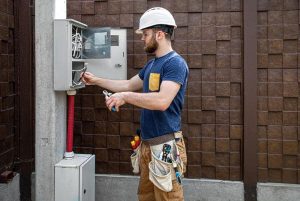The Power of Knowledge: Essential Electrical Safety Tips for Home Troubleshooting
Electricity is a ubiquitous and essential force that keeps our modern lives humming, powering our gadgets, gizmos, and even our domiciles and workspaces. However, fiddling with electrical systems can be a dangerous game, especially if you’re tackling issues without proper know-how and gear. That’s why it’s crucial to be clued up on electrical safety before you start troubleshooting any problems at home. In this blog post, we’ll delve into the gear, precautions, and procedures you need to be aware of when troubleshooting electrical woes.
Equipping Yourself for Electrical Safety: The Must-Have Tools for Troubleshooting
First things first, it’s vital to arm yourself with the right safety tools for the job. This includes rubber-soled shoes to insulate you, rubber gloves to keep you safe from electrical shocks, and eye protection to shield you from any flying debris. Other gadgets you might need include a non-contact voltage tester, a multimeter, and a circuit tester.
Electrical Safety 101: The Vital Do’s and Don’ts for Troubleshooting
When it comes to safety, the most important step is to shut off the juice before you start working. This can be done by flipping the switch at the main circuit breaker or yanking the fuse. Additionally, steer clear of any sources of H2O or dampness, and don’t overload circuits. And always be wary when dealing with live wiring, as it can be a real danger to your well-being.
Finding the Fault: A Step-by-Step Guide to Electrical Troubleshooting
Next, let’s delve into the nitty-gritty of troubleshooting electrical problems. Start by identifying the issue, whether it be a blown fuse, a tripped circuit breaker, or a device on the fritz. Then, track down the circuit breaker or fuse box and test for voltage using a non-contact voltage tester. After that, check the wiring connections and, if needed, swap out the fuse or reset the circuit breaker.
 Electrical Wizards to the Rescue: When to Call an Expert for Troubleshooting
Electrical Wizards to the Rescue: When to Call an Expert for Troubleshooting
If the problem persists or you’re feeling uncertain about the situation, it’s always a good idea to bring in a pro. An experienced electrician will have the know-how, gear, and skills to safely and efficiently diagnose and solve the issue.
Stay Safe, Stay Smart: A Recap of Essential Electrical Safety Tips for Troubleshooting at Home
In conclusion, electrical troubleshooting can be a perilous and complex task, but with the right gear, precautions, and procedures, it can be done with ease. Always be vigilant and don’t hesitate to reach out to a professional if you’re feeling out of your depth. By following these guidelines, you can ensure your safety and the safety of your home while resolving the electrical issue.


 Electrical Wizards to the Rescue: When to Call an Expert for Troubleshooting
Electrical Wizards to the Rescue: When to Call an Expert for Troubleshooting